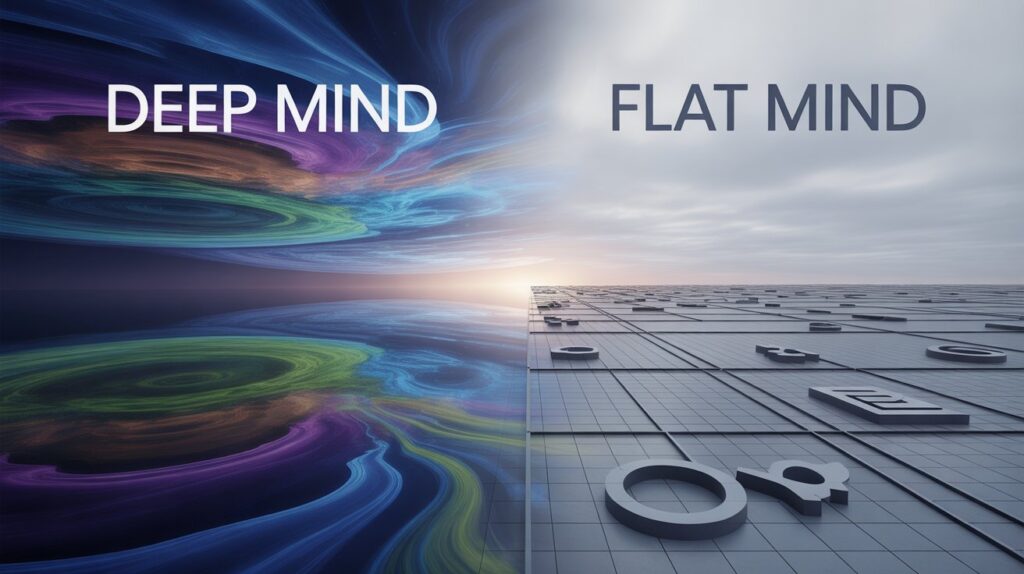⚡️ This is a brief version of the Deep Mind vs Flat Mind concept. An extended, in-depth version is in progress. Leave your questions and comments — your feedback will be taken into account!
Contents
Introduction
For centuries, philosophy has been searching for truth, but rarely has it looked closely at the tool of its search — thinking itself. Various schools have spoken about logic, intuition, and faith, but almost no one has asked: Is thinking structured the same way in all people?
The main distinction between people runs not along the lines of opinions, cultures, or education, but along the type of consciousness. This is not psychology, nor a matter of style. This is ontology: a way of being in the world, a way of handling mystery and limits.
This is how a fundamental difference arises between two types of thinking:
- ⚫️ Flat Mind — thinking that flees from mystery
- 🔵 Deep Mind — thinking that can withstand it

🔵 Deep Mind
A type of thinking that recognizes the ontological inexhaustibility of reality.
It does not fear paradox, does not require complete explanation. It is open, but does not get lost.
Signs of Deep Mind:
- Awareness of the limits of all knowledge
- Meaning is above form; the map ≠ the territory
- Acceptance that not everything can be expressed
- Respect for mystery as a real participant in being
- Ability to remain in dialogue with the inexpressible
⚫️ Flat Mind
A type of thinking that strives to subordinate reality to a model.
It is frightened by openness, demands complete explanation and fixed schemes.
Signs of Flat Mind:
- Belief in complete knowability
- Reducing the world to description
- Denial of the inexpressible as “unscientific”
- Substitution of reality with a model
- The illusion of progress as a movement toward total knowledge
Historical Forms of Fixation
| Level | Attitude to Meaning | Strategy | Examples |
|---|---|---|---|
| Living impulse | Mystery as presence | Dialogue, poetry, silence | Jesus, Buddha, Heraclitus |
| First fixation | Mystery as the highest | Fixation in an idea | Plato, early mystics |
| Systematization | Mystery as an incomplete model | Categorization | Aristotle, scholastics |
| Simplification | Mystery as an obstacle | Removal and reduction | Occam, positivism |
| Cynicism | Mystery as a tool | Control through form | Institutions, corporations |
Diagnostic Power of the Distinction
- Why do people “speak different languages” even using the same words?
- Why is a debate between a materialist and a mystic impossible?
- Why do some strive for control while others seek participation?
The answer: they differ in type of thinking, not in level of knowledge.
The Fundamental Nature of the Hypothesis
The distinction of Deep vs Flat is not just a dichotomy. It is an ontological variable that determines:
- How a person experiences the truth
- what is considered acceptable
- the very way one relates to reality
The Impossibility of Dialogue?
- Deep Mind knows it cannot explain itself to Flat Mind: the language will break.
- Flat Mind is sure that Deep is a fanatic or mystic who needs to be “put in his place.”
- Deep — grows sad and silent. Flat — laughs and judges.
This is not an argument. It is an ontological abyss.
Conclusion
Thinking is a choice.
- One can live within a model.
- Or one can live at the edge of the model.
Here, for the first time, we formulate this map as a philosophical diagnosis of the era, and as a chance to escape the trap of absolutizing form.
Deep Mind recognizes: truth always escapes, and this is not a weakness, but a dignity of being.
Flat Mind says: truth will be ours when we measure everything — and therein lies its tragic mistake.
Truth requires courage, not just clarity.